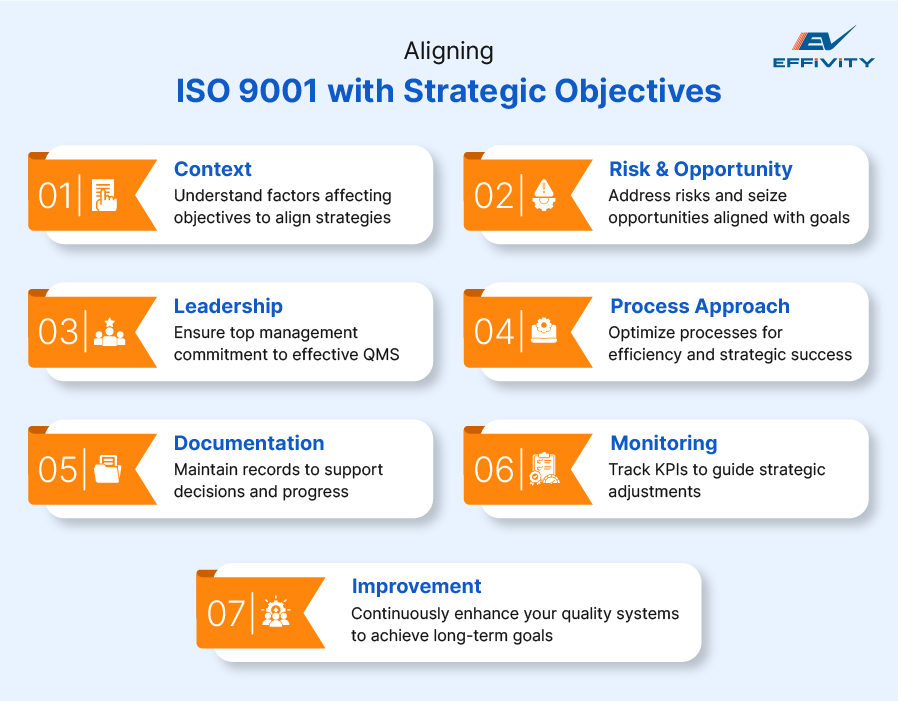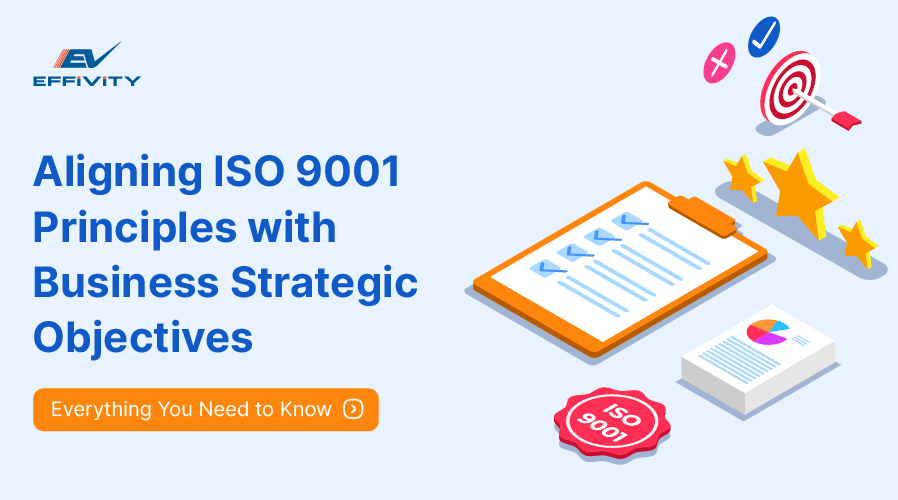Very often we think of quality management and strategic planning as two divorced principles that have nothing in common. This is because strategic planning is the domain of top management who focus on long-term goals, vision and mission, whereas quality management is taken care of at the operational level.
However, with the introduction of ISO 9001:2015, it is impossible to look at quality management and strategic planning as separate activities. It is rather counterproductive to do so. ISO 9001:2015 adopts a more integrated approach that combines various organizational processes and emphasizes factors like context and leadership.
This change in the ISO standard necessitates that all quality objectives in your organization are aligned with the larger strategic direction. Such alignment ensures better organizational cohesive, better strategic decision-making, increased efficiency and a stronger competitive advantage.
Let's now look at the defining principles of the ISO 9001 standard, how these principles can be aligned with your strategic objectives, and how using Quality Management Software can make this easier.

1. Context of the Organization
The "Context of the Organization" refers to understanding both internal and external aspects that can impact your organization's ability to achieve its objectives. By comprehensively understanding your organization's context, you can ensure that your strategic objectives are relevant and responsive to external opportunities and threats.
To align your strategy with the context, you would have to identify and understand the needs and expectations of interested parties. You can also make use of a SWOT analysis to inform your strategic planning.
How QMS Software Helps:
- Collects and stores information on the context of your organization, market trends, customer feedback and regulatory requirements all in one place.
- Generates reports that provide insights into the internal and external context.
2. Risk and Opportunity
Risk and Opportunity management involves identifying potential events that could negatively or positively affect your organization's objectives and developing strategies to mitigate risks or capitalize on opportunities.
To successfully incorporate risk management as required by ISO 9001 into your strategic plans, recognize risks at all levels: strategic, operational, and tactical. Based on this, develop processes to identify and seize opportunities that align with strategic goals.
How QMS Software Helps:
- Helps with risk and opportunity management through systematic risk identification, assessment, and monitoring.
- Notifies relevant personnel of emerging risks or opportunities in real time.
3. Top Leadership Commitment
Top leadership commitment involves senior management actively engaging in and supporting the QMS to ensure its alignment with the organization's strategic goals and direction. When you align your ISO 9001 principles with your strategic objectives, you can ensure adequate resource allocation and employee engagement, as prompted by the leadership.
How QMS Software Helps:
- Provides executives with real-time insights into quality performance.
- Facilitates organization-wide communication of quality policies and objectives.
4. Process Approach
The process approach emphasizes understanding and managing interrelated processes as a coherent system to enhance the organization's efficiency in achieving its objectives. Streamlining your processes as required by the ISO standard can ensure resources are used optimally to achieve strategic goals.
Standardized processes reduce variability and lead to predictable and reliable outcomes aligned with strategic objectives.
How QMS Software Helps:
- Automates and manages workflows to improve process efficiency.
- Tracks process KPIs to identify areas for improvement.
5. Documented Information
Documented information encompasses all documents and records required for the effective planning, operation, and control of processes. Ensures critical information is retained and accessible for current and future use.
Proper documentation ensures that critical information supports strategic decision-making. Maintaining detailed records also serves as evidence for how much progress your organization has made towards its goals.
How QMS Software Helps
- Manages the creation, approval, distribution, and revision of documents electronically.
- Ensures users access the most current documents, reducing the risk of errors.
- Manages documents to control who can view, edit, or approve them.
6. Monitoring and Measurement
Monitoring and measurement involve tracking key performance indicators (KPIs) to check and track the effectiveness and efficiency of processes and the QMS as a whole. Measuring key indicators provides data on progress toward strategic objectives. Analysis of performance data enables informed strategic adjustments and resource allocation.
You must develop KPIs that reflect strategic priorities and use monitoring and measurement to ensure that performance meets strategic goals.
How QMS Software Helps:
- Automates the gathering and analysis of performance data through monitoring and measurement.
- Display real-time KPIs relevant to different user roles and strategic objectives.
- Generate detailed reports for internal reviews and external audits.
7. Continual Improvement
Continual improvement is an ongoing effort to enhance products, services, and processes. It involves identifying areas for improvement, implementing changes, and monitoring the results. It is an important principle of ISO 9001.
If you align improvement projects with strategic goals you can ensure your efforts contribute to long-term success. You can also ensure that improvements you make focus on achieving the greatest strategic benefits.
How QMS Software Helps:
- Plan, execute, and monitor improvement initiatives within the software.
- Manage changes to processes and document the rationale, implementation steps, and outcomes.
- Evaluate the effectiveness of improvements through data analytics.
Final Thoughts
Aligning the principles of ISO 9001:2015 standard without your strategic objectives helps you achieve organizational excellence. Each principle of the ISO standard can guide your strategic plans and help you create a cohesive system where your quality management directly supports and enhances your strategic goals.
A comprehensive QMS Software solution supports your efforts in this direction and provides you with all the tools you need to implement, manage, monitor, improve, and automate your quality management system.
Effivity's QMS software is a user-friendly solution that helps you integrate your QMS principles into your strategic planning. Visit the Effivity website for more details and get in touch with our team for a personalized consultation call.






























